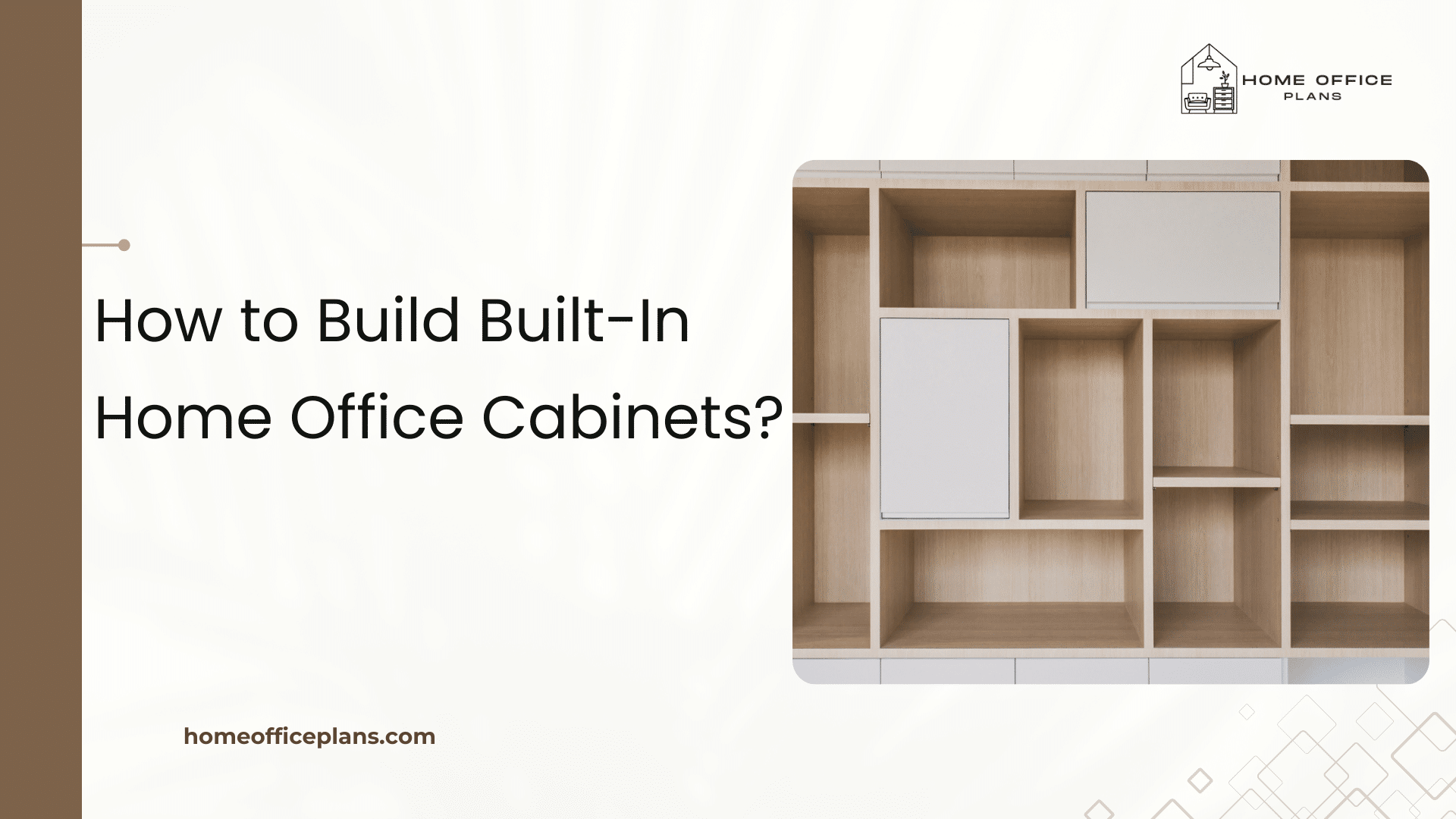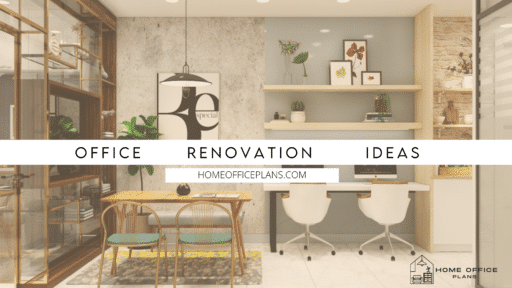
If you are looking for ways to maximize the storage space in your home office, you have come to the right place. I understand that when you are working remotely, it’s hard to set up everything in a limited space. No. Whether you are choosing the shed for your home office setup or bedroom, you’ll always have to adjust your stuff to avoid cluttering. This is where the built in home office cabinets kick in. Not only are they space-saving, but they also offer aesthetic value to your office setup. Do you know that you can build these DIY space-saving marvels at home with ease with just the right tools? If not, don’t worry and gear up to try out a step-by-step guide to designing ultimate cabinets. Let’s help you construct a home office cabinet wall unit all by yourself.
Hey folks, once you have decided which door design would fit best with your home office, now it’s time to make the most of this limited space. We are here with our article guide to help you with the home office built-in cabinets featuring different colors and styles.
So, without further ado, let’s get right into the guide.
Design and Planning
The first step to constructing built-in office cabinets for a home office is planning. For almost every DIY project, research and planning are important. A question might be popping into your mind: What is involved in the planning phase for building cabinets? We’ve got you covered.
1. Measure the Space: For a home office with built-in cabinets project to be effective, accurate measurements are important. Measure the home office where the cabinets will be placed using a tape measure to determine its height, width, and depth. Consider any possible hindrances that can affect the design, such as base cabinets or electrical outlets.
2. Sketch the Layout and Design: Once you have measured the needed space, Making a sketch of your design helps in picturing the end result. Add information about the number, size, setup, and special features (e.g., integrated Built-in desks or storage units) of the cabinets. Throughout the building process, you can make changes to this rough design before deciding on the final build. It will act as a guide.
Assemble Materials and Tools
1. Materials: Selecting high-quality materials will extend the lifespan of your cabinets. Solid wood works best for face frames and cabinet doors, whereas plywood or medium-density fiberboard (MDF) is frequently used for cabinet boxes. Make sure you have enough knobs, hinges, drawer fronts and slides, screws, and other hardware to finish the project.
2. Tools: This project requires a measuring tool to ensure accuracy, a tape measure for exact measurements, sandpaper for finishing touches, a drill for drilling holes and fastening hardware, a screwdriver for assembly, and a circular saw or table saw for material cutting. This step is very important in the home office built-in office cabinets guide.
Cabinet Building
1. Cutting the Materials: Coming towards the next step of the home office built-in wall cabinets guide, you need to cut and shape the cabinets. Carefully cut the plywood or MDF into panels for the cabinet box using the dimensions from your design. To guarantee precise cuts, use a straight-edge guide. Furthermore, ensure that the face frame’s wood strips are cut to the exact measurements of the cabinet box.
2. Putting the Boxes Together: Start constructing the cabinet box frames for custom home-built marvels by screwing and wood gluing the panels together. To ensure that the boxes are square and robust, use clamps to hold the pieces in place while the glue cures.
3. Adding Face Frames: After the cabinet boxes are put together, use glue and screws or nails to attach the solid wood face frames to the front. For a seamless appearance, make sure the face frames are lined up with the cabinet box borders.
Cabinet Installation
1. Find out Wall Studs: To locate the wall studs where the cabinets will be installed, use a stud finder. To guarantee precise installation, use painter’s tape or a pencil to mark the locations of the studs on the wall.
2. Mounting Cabinets: Set the cabinets up against the wall, making sure they line up with your layout and are level. With a drill, firmly fasten the cabinets to the wall studs by inserting screws through the rear panel of the cabinets and into the studs.
3. Adjustments: Before fully fastening the cabinets to the wall, use a level to double-check their alignment and make any required modifications. For a polished appearance, make sure the cabinets are straight and well-spaced.
Installing Hardware and Doors
1. Creating Openings: Using the same solid wood as the face frames, build the cabinet doors. Measure the wood and cut it to the appropriate size and style. A variety of door types, including raised panel, flat panel, and glass inserts, are accessible for selection. This step ensures the durability of home office built-in wall cabinets.
2. Mounting Doors: Assemble the doors to the cabinet frames in keeping with your design by putting hinges on them. After securing the hinges in place using a drill, make sure they are properly aligned for seamless operation. Before continuing, make sure the doors open and close properly by testing them.
3. Setting up Hardware: To finish off the look of your cabinets, add knobs or handles to the doors and drawers. Select hardware that is both easily accessible and blends in with the design of your cabinets. Assemble the hardware firmly using a drill or screwdriver, making sure everything is in place and working properly.
Final Touches
1. Sanding and Painting: Sand the cabinet surfaces to remove any sharp edges or flaws once they have been built and put in place. For a smooth finish, start with coarse-grain sandpaper and work your way up to finer grits. Prime the cabinets in the colors and styles that you have in mind before painting or staining them.
2. Adding Shelves and Accessories: To optimize storage space and organization, install shelves within the cabinets. After that, to improve the utility of your cabinets, think about including extra accessories like built-in charging stations, wire organizers, or lighting fixtures.
Time for Final Inspection
1. Make Sure It Functions: Finalizing it up, the next step of built-in cabinets for the home office is checking out the functionality of your wall office cabinets.
All you need to do is to make sure the cabinets work properly before considering the project completed. Make sure there is no sticking or binding when you open and close the doors and drawers by giving them a test. To enhance performance, adjust the hinges or screws as needed.
2. Cleaning Up: After your home office’s built-in cabinets are practical and look good, clean up the workspace by clearing out any trash, sawdust, or materials that are left over after giving your home office a thorough cleaning with a damp towel in order to remove any dust or filth, enjoy the office built-in storage cabinets in your newly designed area.
Follow these detailed DIY home office built-in cabinets guide and save money.
However, you can check the detailed process of constructing cabinets in Kenya’s article.
Designs of Built-In Home Office Cabinets

You should know that you can play with different design shapes that fit your personal tastes when it comes to built-in cabinets. There are many different styles of built-in office cabinets, and each one has special functions and an appealing look. Here are a few various designs to take into account:
1. Traditional Style Cabinets
- Raised Panel Doors: Raised panel cabinets display a timeless, classic appeal and frequently include ornate door front detailing.
- Crown Molding: By adding crown molding to the cabinet tops, you can improve their classic appearance and give them a glossy finish.
- Warm Wood Finishes: To go with traditional decor designs, use warm wood finishes like mahogany, oak, or cherry.
2. Modern and Minimalist
- Flat Panel Doors: Cabinets using flat panel doors have a basic, clean style that radiates a sleek and minimalist appeal.
- Handleless Design: For a smooth and simple appearance, think about using push-to-open mechanisms or integrated finger pulls on cabinet doors.
- High Gloss Finishes: For a modern look, go for high gloss finishes in neutral colors like white, black, or gray.
3. Scandinavian-Inspired
- Light Wood Finishes: Birch, maple, or ash are common light wood finishes seen in Scandinavian-style cabinets, which give the home office a light and airy atmosphere.
- Simple Lines: For a Scandinavian-inspired aesthetic, keep the design simple and uncomplicated with minimalist hardware and lines.
- Functional Storage Solutions: To increase efficiency and organization, use functional storage solutions, including modular components and open shelves.
4. Industrial Chic Cabinets
- Metal Accents: Use metal accents, including exposed hardware, drawer pulls, or metal mesh inserts on cabinet doors, to give your home office cabinets an industrial feel.
- Raw Materials: For a rough and industrial aesthetic, go for raw materials like concrete, distressed metal, or salvaged wood.
- Open Shelving: For a stylish and useful storage option, include open shelving units. These structures are constructed from industrial materials like steel pipes and reclaimed wood.
5. Built-in Desk Cabinets
- Integrated Desk: To create a unified and useful workspace in your home office, combine storage cabinets with a built-in desk.
- L-shaped or U-shaped Configuration: To optimize the workspace and offer a variety of storage options, use an L-shaped or U-shaped desk design.
- Concealed Storage: To keep office supplies and files well arranged and hidden from view, including drawers. You can also add cupboards below the desk surface.
Conclusion
Summing up, this article covered a detailed discussion on a step-by-step guide for constructing cabinets for the workspace. Following this article guide, you can create marvels without breaking the bank. Moreover, you can choose from various cabinet designs. All you need to do is select the design that matches your taste and install it in your workspace for improved storage solutions.
Try Out This DIY Wonder!




